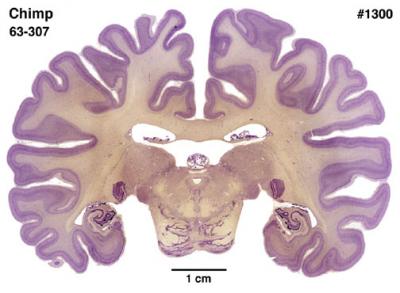 12:01 11 October 2006
12:01 11 October 2006 NewScientist.com news service
Roxanne Khamsi
The human brain may have evolved beyond that of our primate cousins because our brain cells are better at sticking in place, researchers say.
A new study comparing the genomes of humans, chimps, monkeys and mice found an unexpectedly high degree of genetic difference in the human DNA regions that influence nerve cell adhesion, compared with the DNA of the other animals.
Accelerated evolution here allowed human brain cell connections to form with greater complexity, enabling us to grow bigger brains, the researchers suggest.
The genetic assembly of the ten billion neurons in the human brain relies on precise expression of adhesion molecules that allow for thousands of connections between neurons and the matrix of proteins around them.
“Cell adhesion controls many aspects of brain development” including growth and structure, says Shyam Prabhakar at Lawrence Berkeley National Laboratory in Berkeley, California, US, who carried out the genetic analysis with colleagues.
Tests are now needed to reveal whether levels of proteins involved in nerve adhesion do in fact physically differ between the brains of monkeys, chimps and humans, as suggested by the DNA findings. “We don’t have any [physical] changes to link the genetic changes to,” explains Todd Preuss at Yerkes National Primate Research Center in Atlanta, Georgia, US.
Prabhakar will present the findings at the American Society of Human Genetics meeting in New Orleans, US, this week.

No hay comentarios:
Publicar un comentario